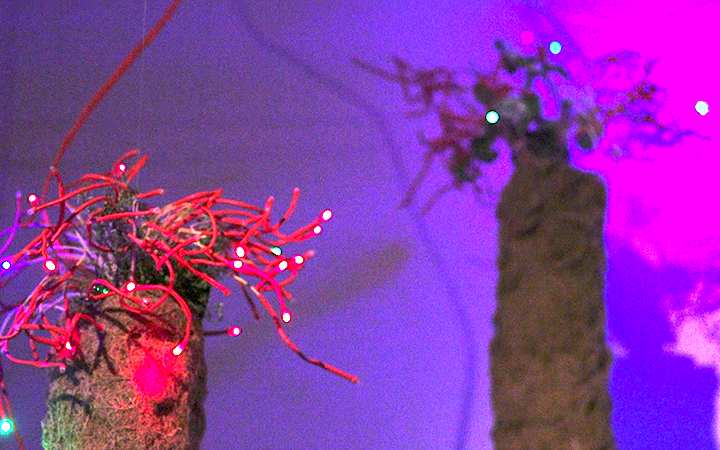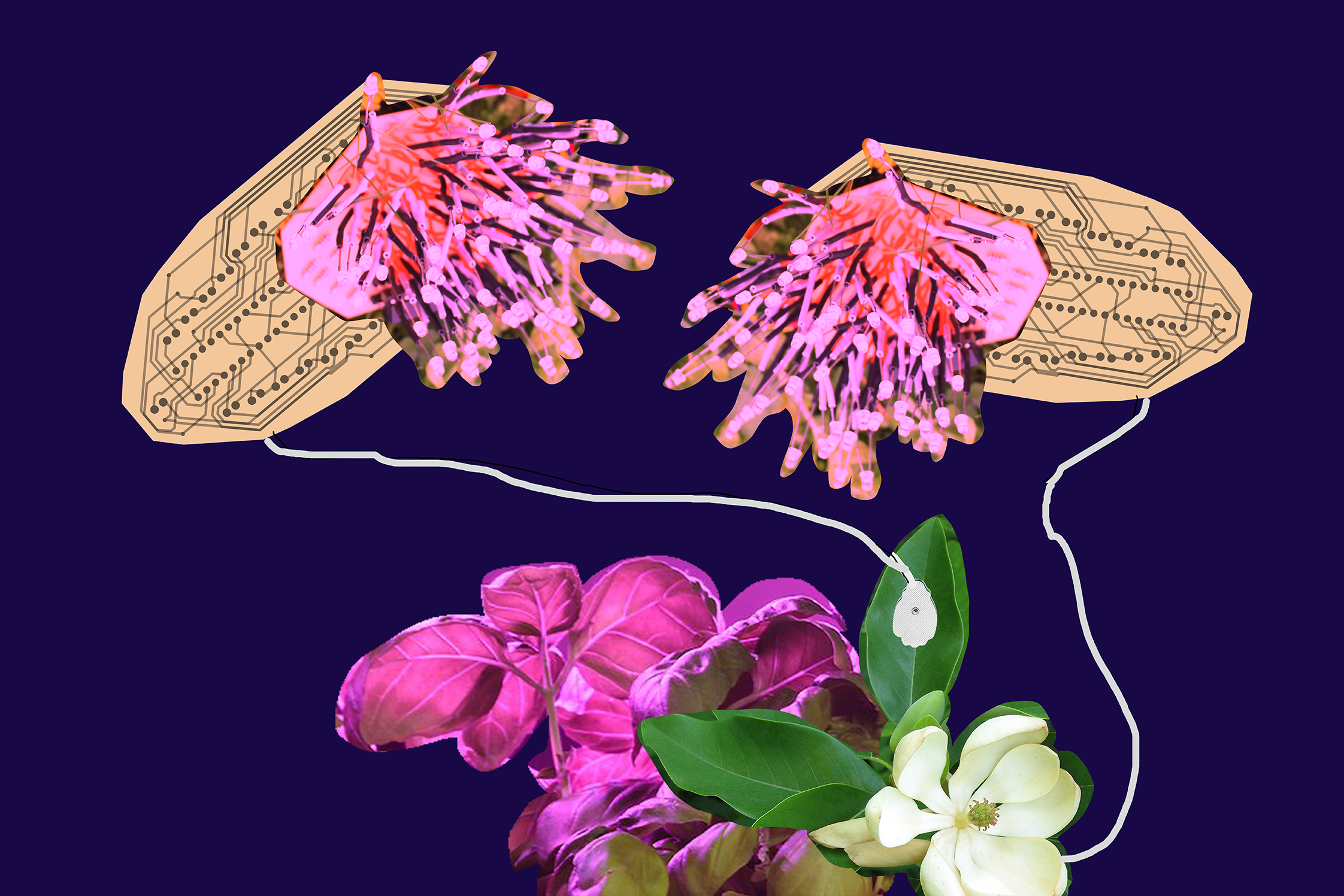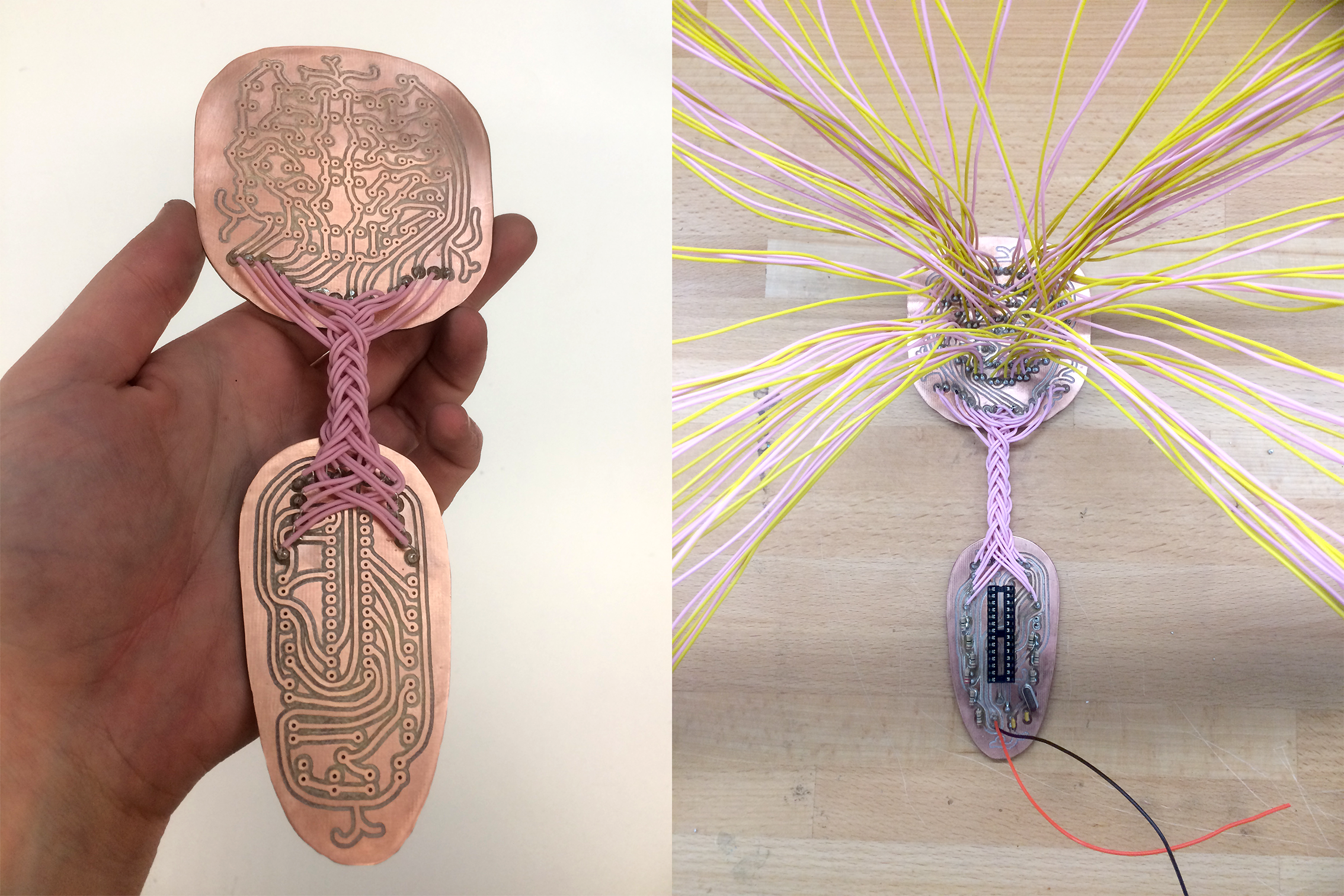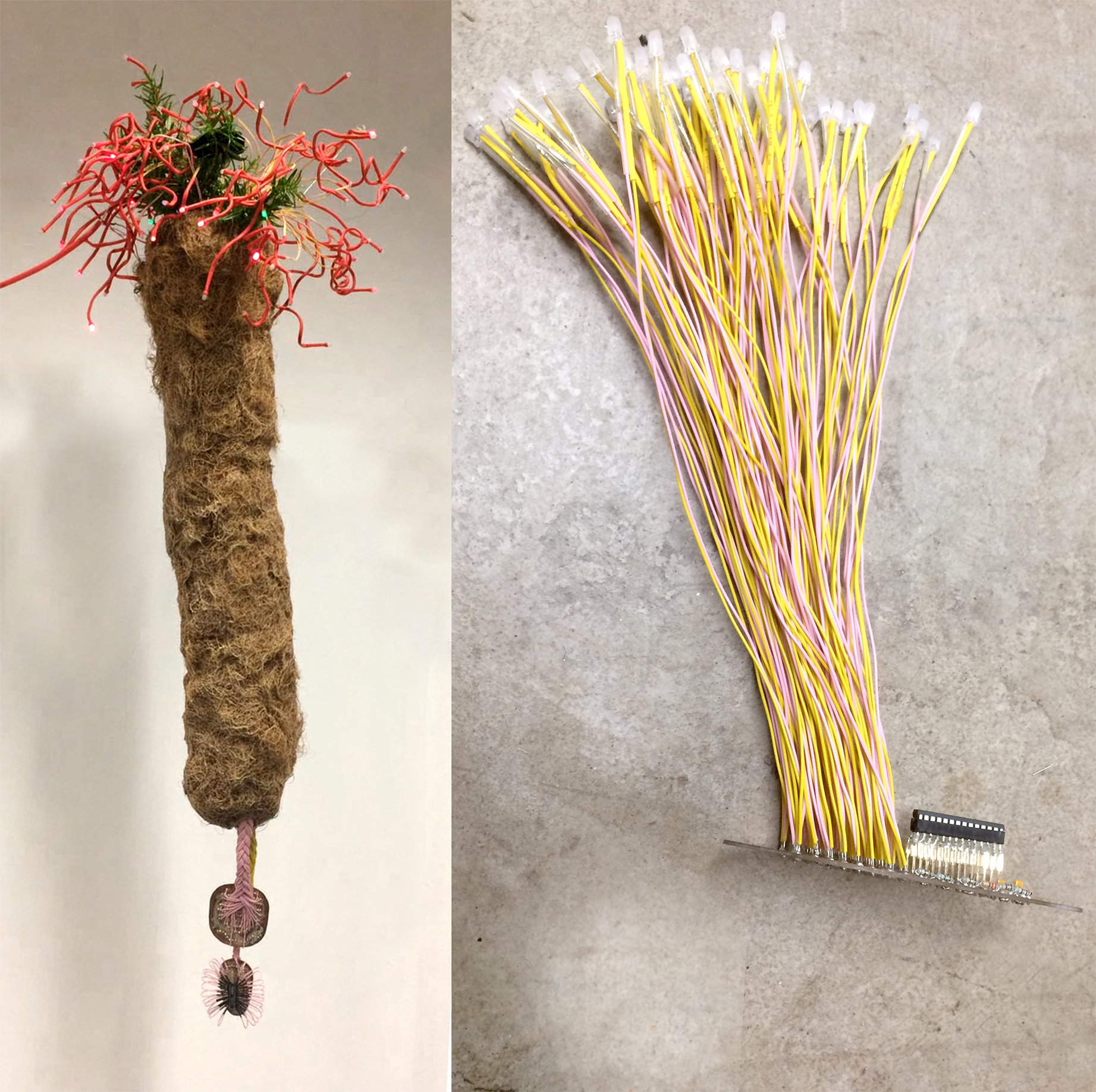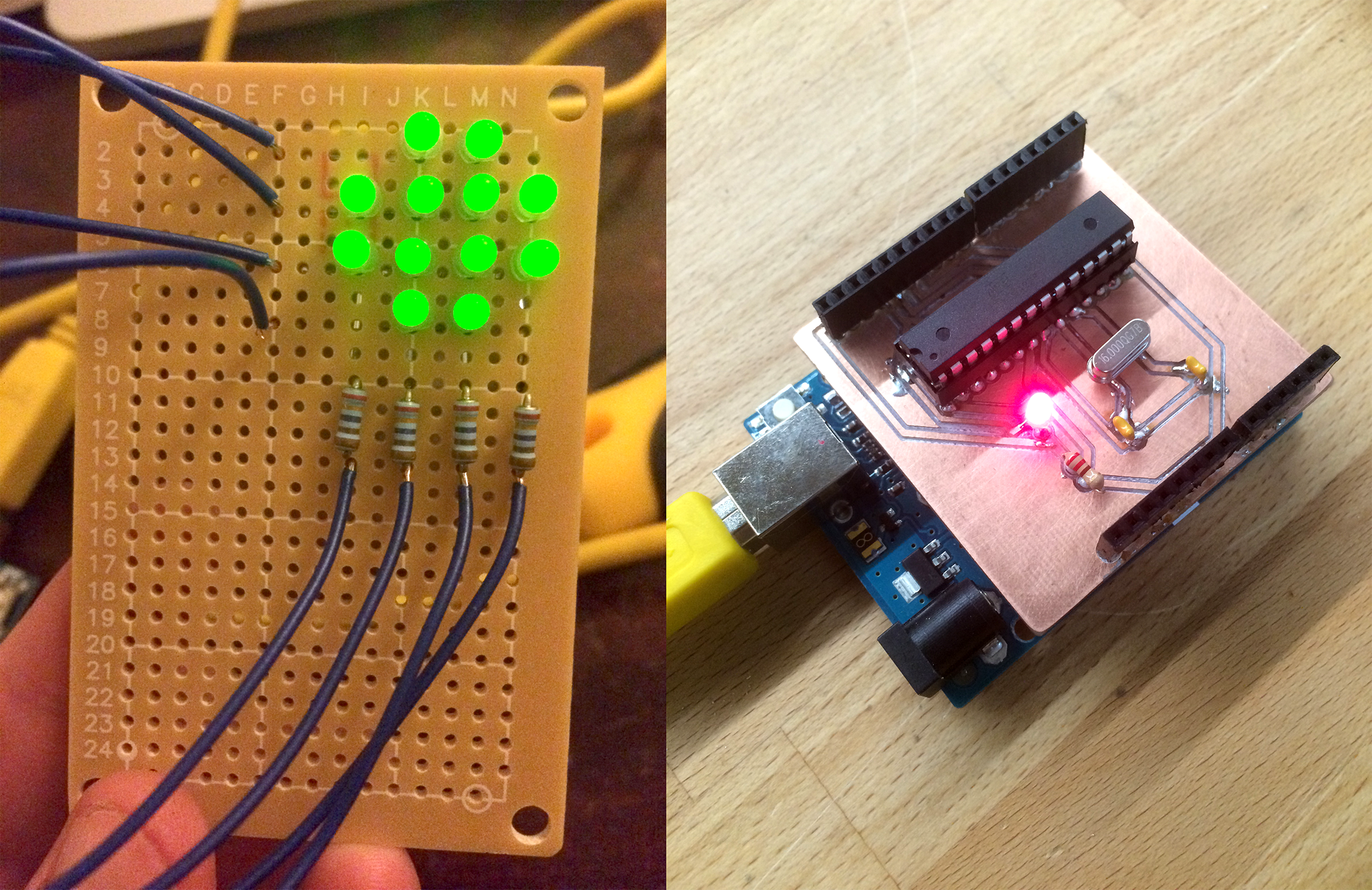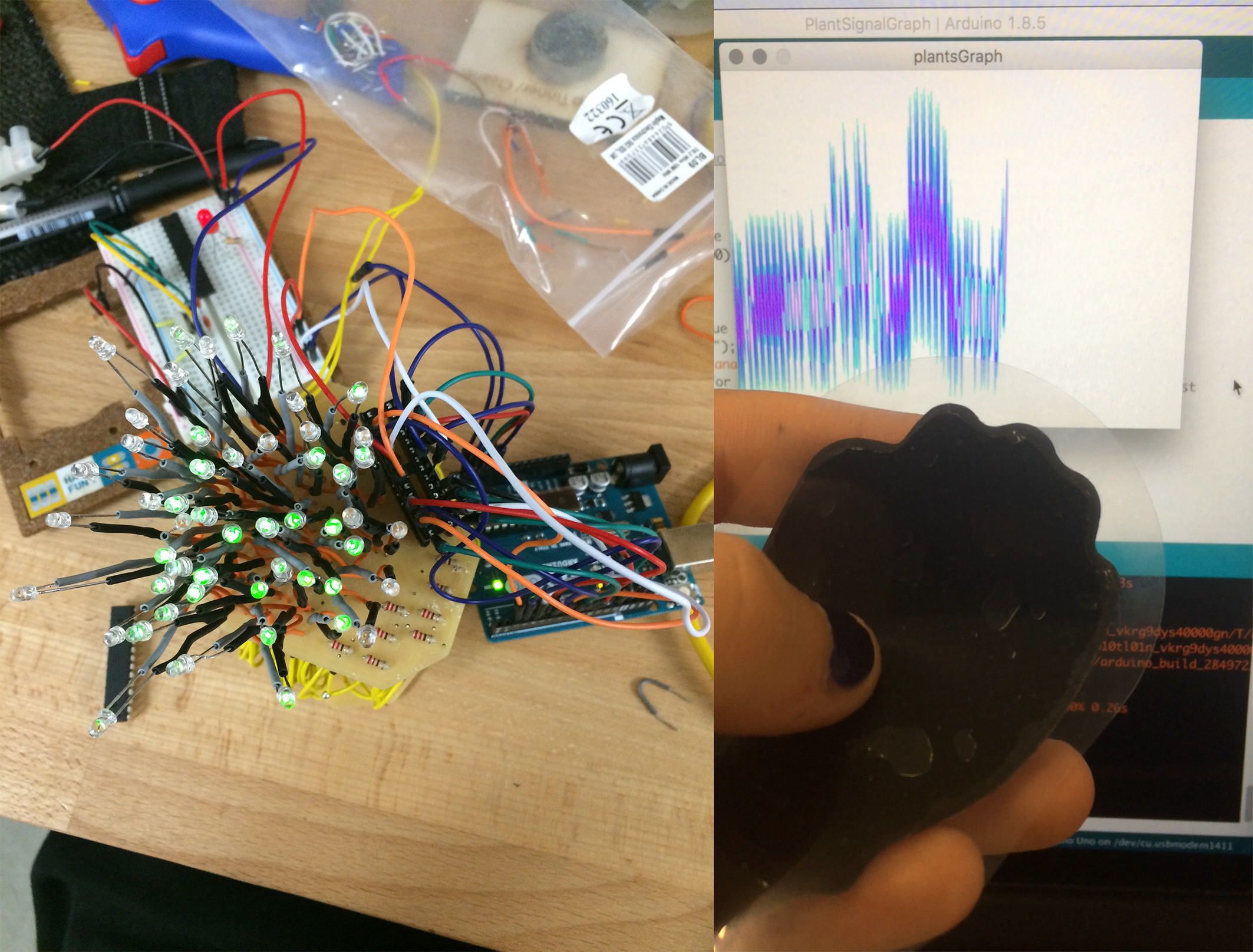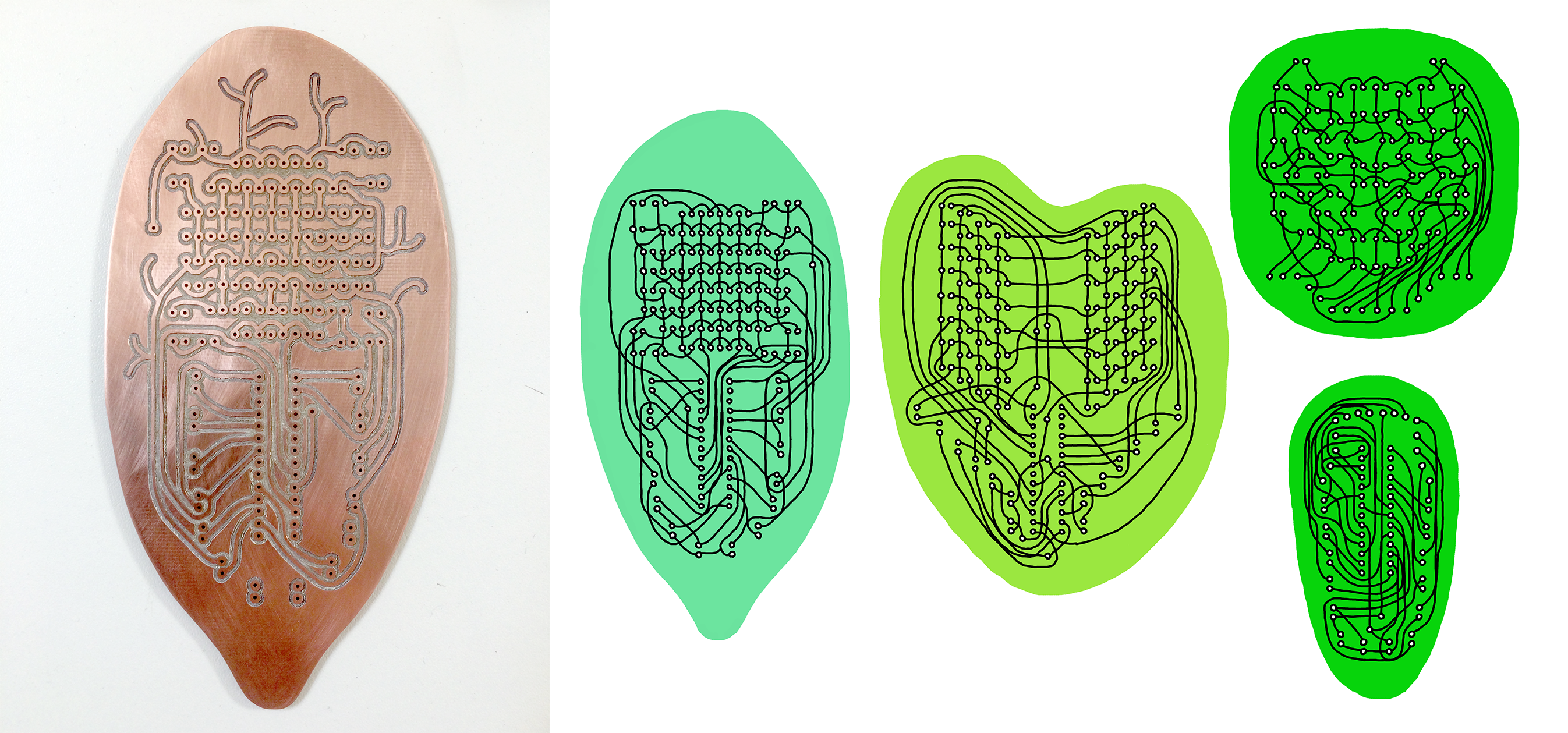Digital Symbiote
An installation exploring ideas about technology, plants and gender. A feedback loop system between plants and custom-built circuit boards imitates the biological phenomenon of a symbiotic relationship.
produced by: Megan Bates
Introduction
The Digital Symbiote is a mutually beneficial symbiotic relationship between electronic weaving and herbs. Like a lichen or coral, these two 'critters' entangle, penetrate and sustain each other as a single entity. Without light from the circuitboards, the plants will die, and likewise the LEDs will become inactive without regular life signals from the electrodes which connect them to the plants. What are in symbiosis are not just the organic and technological, but the values of wildness/culture, femininity/masculinity that are attributed to each. What emerges are queer objects which demonstrate alternative futures where technology can be wild, and organisms can be computational.
Still from film of installed final piece.
Concept and Research
This sense of combining or ‘becoming-with’ has developed from my essay work ‘Athenian and Medusan interactions’ which explored dynamics between traditionally separated concepts such as masculinity/femininity, culture/nature and mind/body. Using Feminist Technoscience, Companion Theory and Queer Theory, the digital symbiote is an exploration into crossing these violent borders. It is a speculation on what alien aesthetics might appear in a framework less concerned with categorisations of gender, peoples, and life-forms.
Several art projects involving plants and technology helped define what I wanted the digital symbiote to be. Plant data has been used by artists such as Mileece to make music, using the plants as a kind of collaborative agent. Other projects such as those by Sommerer/Mignonneau investigate human-plant interaction and artificial life. I used Donna Haraway’s Staying with the Trouble as a foundation for material and aesthetic decisions throughout the project. Her writing presented me with multiple angles to approach bridging the gap between the technological nonhuman and organic nonhuman. She originally inspired me to write about Medusa, and also discusses very interesting ideas about symbiosis and composting which have become central to this artwork in particular. The Queer Feminist Science Studies Reader was another helpful resource, as it introduced me to the concept of queer artworks. It also parses out how femininity, wildness and nature are often conflated, and set in opposition to masculinity with culture, technology and rationality.
I found Eva Hesse, Louise Bourgeois, Robert Breer, Hito Steyerl and Lawrence Lek useful touchstones in determining what impression I wanted my work to leave on the audience. Referencing their work helped me to figure out how blur the sense of the technological with the ‘compostible’, what temporal qualities I wanted to achieve, and how I wanted the work to relate to the bodies witnessing them. Other research touchstones included the field of artificial life, craft disciplines, and colour theory.
Design
Through building circuitry for early prototypes, I discovered a number of interesting aesthetic qualities of the material of circuitry I could exploit.
Early prototype of multiplexing circuit board design.
I had originally intended the organic motion of the game of life to be the demonstrator of computations' organic qualities, but increasingly I found this came naturally through working with circuitry. My first large multiplex prototype had an anemone-like quality I wanted to further emphasise.
Early concept sketch of final piece.
3D print of sculpture, photoshop concept art of final piece.
Throughout the design process, I focussed on emphasising both organic and feminine qualities, through colour choice, using weaving, circuit board shape, and hand-tracing connections rather than using autogenerated paths. I had the happy coincidence that optimal wavelengths for grow lights create a pink/purple hue, which I kept in mind for other material and colour choices.
Alternative concept work for the final piece.
Circuit board design and soldering.
I found heat-shrink in particular to be an interesting sculptural medium, using it to create wavy tendrils which ended in LEDs. The most exotic material I worked with was the pot material which housed the plants and circuitry, which I wanted to give the impression of circuitry and root systems entangling within. I decided to make it of a similar material to biodegradable seedling pots, which I discovered are made of coconut fibre and latex. I managed to create a facsimile in the shape I wanted by casting the mixture around long latex party balloons.
Assembled final piece and soldered board with LEDs and other components.
Technical development
Several stages of building and starting over occurred through the creation of the digital symbiote. The circuitry uses multiplexing, which requires a complex circuit design. I made several iterations, each becoming increasingly complex and refined. I didn’t want the boards to rely directly on Arduino, as the boards themselves I wanted to be a prominent visual component of the work. I worked to make the board run using only ATmega and a power supply. I also built an Arduino shield to enable me to quickly program ATmegas without a breadboard.
Early multiplex and ATmega shield for programming with Arduino.
Initial prototypes involved practicing wiring multiplexes, running off Arduino. This made it possible to write and test programs which could control indefinitely large multiplexes to play the game of life. I then built a multiplex of the scale I wanted the final boards to be, to run using ATmega, but discovered I needed crystals and capacitors on the board for the ATmega chip to function properly without Arduino.
First large working multiplex and electrode data analysis.
I wanted to build a symbiotic relationship between the circuitry and the plants, so I spent some time experimenting with electrodes, analysing the signals using Processing and adjusting the system which determined what signal would be sufficient to demonstrate plant activity. I then adjusted this further to refresh the game of life at a pace which created pleasing results. In redesigning the circuit board with the new component arrangement, I used hand drawn traces and smooth, leaf shaped boards, with 3 different board designs. Each served the same function for its pot, of controlling the multiplexing of LEDs.
Different designs of multiplex boards (of identical functionality) to have a unique board appearance for each pot.
I originally planned to have very long wires from the very bottom of the pot to the top where the LEDs would be, but on assembling a board with wires this long found the wire resistance to be too high, meaning the LEDs were not provided with sufficient voltage. To solve this problem, I used shorter wires and created second copies of each board to be hidden at the top with the plant, using a second, non-powered board displaying the design and wire weaving work at the bottom.
Still from film of installed final piece
Unfortunately, an as yet unsolved bug with the ATmega meant it was not resetting the program properly, so, late in the project I had to build relays to hard-reset the boards by switching power off and on. This was reasonably simple and the Arduino controlled relays were hidden along with power supplies away from the displayed work.
Future Development
I want to continue to develop my understanding of colour theory. I am interested in its positioning as a locus of emotive and scientific understanding. I also feel that it relates to technology interestingly, though both the loss of many colours (RGB screens can only display a very small gamut of visible shades of green) and a field of discovering new ones- artificial lights, Vantablack etc. I also want to study sexuality’s relationship to technology, which I feel links meaningfully to colour theory and plantlife through what I have discovered with this project. The new world of gender and sexuality which has been explored across the internet amidst often unnerving and bizarre aesthetics is inspiring to me. The technology we use to interface with this new world is so often corporate and clinical, and bad at drawing distinctions between social worlds (eg. work and sex). I would love to develop my technology building to be involved in complex worlds of human and non-human experience, motivated by forces other than capital.
Self Evaluation
I feel that I managed my time well, leaving space for several iterations of prototypes, although I could have benefitted from a little more time to develop a more sophisticated expression of the nature of the plant data. I have been surprised in this project by the amount I managed to achieve in a fairly short time-frame. I was aware that I was very ambitious in planning to make several very complex circuit boards of different designs.
The final work could have done more to express issues of gender in a way that was immediately obvious. I think the most apparent expressions of this were in the colour choices and weaving, but this was not as direct and apparent as the plant-technology relationship. I think emphasising further the gender subject matter in the work could have made the work more interesting, and the analogues more obvious. My installation process had some serious setbacks, including falling off a ladder, meaning I wasn't able to finish installing the work myself. I would have liked to experiment further with the arrangement and lighting of the work, as I felt in the final exhibition that the works felt ‘flat’- I wanted more of an impression of depth to entice visitors to wander amongst the objects. It would have been good to try bringing the pots further into the space, and to explore lighting some areas of the work more brightly, particularly investigating colour dynamics and drawing more emphasis to the circuit board designs. I would have liked to develop further a sense of stumbling across some bizarre, alien objects. Ideally, it would be interesting to exhibit again in an outdoor environment, perhaps a forest or abandoned building.
References
Gardner, Martin 1970. Mathematical Games – The fantastic combinations of John Conway's new solitaire game "life", Scientific American. 223: 120–123.
Cipolla, C. Gupta, K. Rubin, D. and Willey 2017, Queer Feminist Science Studies, University of Washington Press.
Haraway, D. 2016, Staying With the Trouble, Duke University Press Books.
https://processing.org/examples/gameoflife.html
https://www.arduino.cc/en/Tutorial/ArduinoToBreadboard
https://www.instructables.com/id/two-ways-to-reset-arduino-in-software































































